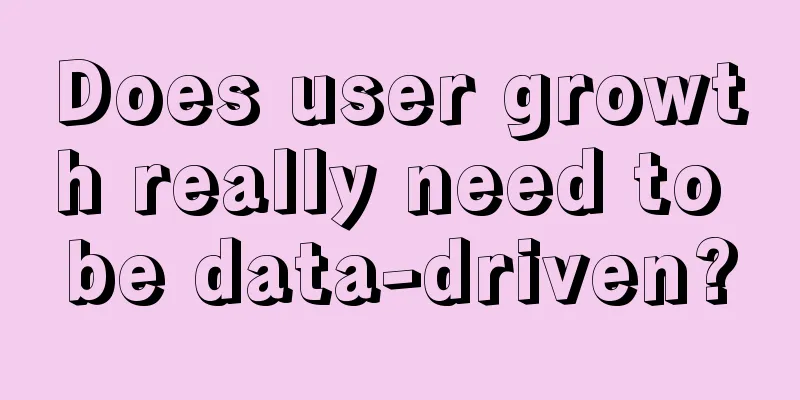Does user growth really need to be data-driven?

Growth must be driven by data, but data is more about setting a hurdle in user growth traffic, or finding new niche markets in the mature decline period to achieve a second growth curve. Generally, the volume growth stage of user growth is rough, either burning money or finding the value point of product reputation. The logic of user growth is to find increments, while data-driven is more about filtering traffic, which are essentially contradictory. Data-driven is doing stock business. I said a long time ago that the ability of data is precision. So does data-driven development have no meaning in the context of user growth? Not really. First of all, precision is the logic of doing business with small and medium-sized enterprises and products, because small and medium-sized enterprises are more focused on the ROI (short-term profit) of current things, while large enterprises are more concerned with medium- and long-term value. This is why performance advertising (precision marketing) is done for small and medium-sized enterprises. If large enterprises only do precision marketing, they will not be able to spend their marketing budget. The core of large enterprises is the reasonable division of traffic and the maximum utilization of the ecology. To put it bluntly, ecology is the long tail, which is the multi-channel filtering of traffic. There are a few things that are certain about the data-driven growth of users: One is the attribution of the user source channel, which is also the logic throughout digital marketing, that is, where the money I spent is effective, and the data can be tracked and measured. However, what is more important here is the attribution logic of users coming in through multiple touchpoint channels. In essence, it is also to measure ROI and in which channels can the volume be greatly increased. Another is the logic of precise delivery, which has now evolved into the concept of oCPX (oCPCoCPAoCPS). Originally, due to the limitations of data technology, when analyzing data offline, the algorithm characteristics would be analyzed through offline seed populations, and then the logic of selecting and amplifying potential users would be performed through solidified models. Today, real-time data has become more mature, and the offline training iteration process has evolved into real-time algorithm optimization, which has become real-time algorithm iteration to achieve greater accuracy and efficiency. This is a very direct way to improve ROI, but as a result, more and more delivery agents have shifted from delivery optimization to pure channel resources. 1. Digital Delivery ScenariosThere are several core scenarios in precision delivery:
By stringing together the workflows that arrange and combine these methods, we can achieve precise delivery of SOPs in different scenarios. Of course, this involves relatively strong data technology. Let’s take a digital delivery scenario as an example: The essence of precision delivery is to reduce conversion costs and improve ROI. The goal of attracting new users, activating old users, and recalling lost users is registration costs, while the other goals are paid costs. Let's take optimizing the cost of attracting new registrations as an example. Low cost means that the exposed audience has a high match with the target users. The people with purchase intentions must be the most accurate. User characteristics can be used as a population targeting strategy. So we will target people with high purchase intentions. How do we select this group? Combined with the existing mature data technology, the above-mentioned methods can be used to select the crowd. In the new customer acquisition scenario, it is different from other scenarios in that it cannot be targeted through the crowd package method , and can only be optimized through feature analysis for feature-targeted selection of out-of-domain users. Because it is a new user, this user is not in your user pool (of course, the potential customer scenario is another special case, which is also the core scenario in digital marketing. The anonymous users in the early DMP are mainly in this scenario). 2. Overseas Precision DeliveryFirst, we can use historical transaction users as seed populations, conduct label portrait analysis and perform look-alike on the population outside the domain. At the same time, we can optimize the characteristics of dynamic target populations by connecting the seed populations with real-time conversions through oCPX, making it more and more accurate. Now, most mature traffic platforms support oCPX. Here, user portraits can be divided into in-domain and out-domain portrait analysis, as well as different out-domain delivery domains. Because the current labeling system is mainly based on predictive labels, the labeling systems and rules of different platforms are different and must be in line with the platform attributes. For in-domain portraits, it involves label prediction of behavioral preferences, and users are labeled after model training based on the behavioral characteristics of the seed population. So what is the role of user portraits? In the past few years, user portraits were more used to guide the directional strategy of delivery, but now as smart delivery becomes more mature, portraits are more used to guide the creation of materials and the acceptance of new users. Although portraits are the output of labels, the uses of portraits and labels are very different, so I won’t go into details here. For details, please see my previous article: How User Portraits Are Used for Data-Driven Whether it is advertising or natural traffic, when a user comes in through multiple channels, it is necessary to know how to evaluate the value of each channel and invest limited resources in high-value channels. Channel attribution is essential, such as this year Alimama launched the upgraded MTA Uplift (Multi-touch Attribution, attribution of the entire consumption path) channel analysis attribution model. I will not elaborate on the Alimama model, you can check it out yourself. However, one thing that is interesting is the "historical tracing and analysis capability" of this model, which reminds me of the traffic tracing and simulation capabilities used to verify the effectiveness of the strategies recommended by machine learning when I was doing intelligent risk control at Alipay. In terms of attribution of delivery channels, the deduction of delivery strategies through tracing and simulating the behavior of historical traffic is really innovative. In fact, the biggest difference between off-domain delivery and on-domain conversion is whether the algorithm is deployed on the third-party traffic side or the first-party advertiser side. For example, the CTR user click-through rate prediction model that I will talk about soon, and similar prediction models. 3. In-domain registration conversionThe CTR model actually predicts the user's click probability through historical behavior. This method is common in various search ranking and recommendation scenarios, so it will be involved in any scenario involving exposure and clicks. In the delivery scenario, because the underlying logic of delivery is the CPC or CPM click exposure price , in order to reduce the conversion cost, it is essentially to increase the exposure and click probability. At the same time, there is another competitive dimension that the platform needs to consider, which is the question of who (advertiser) the traffic is given to. In addition to the highest bidder, whoever has a higher probability of clicks will be exposed. The same is true for conversion within the domain. The only difference is that the new customer acquisition scenario is the conversion of potential customers, while the other scenarios are the conversion of existing users. However, the data acquisition methods and data types of potential customers and existing users are different, because existing users have a large amount of domain data accumulated, while the domain data of potential users is very sparse. In fact, whether it is CTR click probability, registration conversion or purchase conversion, the essence is to optimize based on the different algorithm goals. This involves several very core links, namely behavior tags and user portraits. User portraits are used as the basis for selecting the target population, and labels are used as training features. Of course, user portraits can be used as both targets and results. In essence, the model is an accurate user portrait . Different users will always surprise you, so refined operations require user grouping and group portrait operations. When user performance does not have obvious business characteristics, it is difficult to define it through expert experience. At this time, it is necessary to use algorithms to find some characteristic differences and significant performances through crowd clustering. I will not go into details about clustering and algorithm models. For details, please refer to my previous article "In-depth Data Analysis Thinking". Therefore, the core of data-driven is how to better apply data technology to business scenarios to solve problems and realize automation and intelligence through data. The role of data is more in "screening". This seemingly complex but actually simple principle is the best. Once you know the underlying logic and framework, you will naturally understand how user growth is data-driven. |
Recommend
Is it easy to run a Facebook store? Which site is easier to run?
Everyone must have some understanding of Facebook....
Xiaohongshu's compliance operation guide, no more "violation letters"
There is no doubt that Xiaohongshu e-commerce has ...
Douyin takeaway, the sound gradually fades
Douyin Takeout has gradually adjusted its plan sin...
One video gained 140,000 followers. This track is making rapid progress on Xiaohongshu
A video about dismantling a home gained 140,000 fo...
Order Luckin Coffee on JD.com, and Meituan will cry for it
JD.com recently launched a new service that allows...
What to do if a new product on Amazon fails to take off within a month? How to save it?
Many friends have launched new products after open...
Looking at vertical user operations from three dimensions
The simple understanding of vertical users is to o...
What is NIO’s intention in crossing over to sell coffee?
Exploring the brand strategy behind NIO's cros...
How do Chinese sellers join Ozon? What are the requirements?
Ozon is a B2C e-commerce platform in Russia and th...
What are the three types of Amazon ads?
Merchants who open stores on Amazon basically adve...
An inventory of banned words on 6 major platforms including Xiaohongshu, Douyin, and Video Account
As the saying goes, it is better to be safe than s...
How to get a refund on Amazon Japan?
Whether shopping on domestic apps or on foreign e-...
What is the limited-time subsidy offer for Amazon FBA first-leg freight?
In order to help merchants expand their sales busi...
2024 Spring Festival Homecoming, Xiaohongshu Sponsoring Spring Festival Gala, Competition in the Milk Tea Industry
The Spring Festival has passed. During your return...
Xiaohongshu e-commerce promotes store broadcasting, merging buyer operations with merchant operations
This article introduces the relevant information a...









